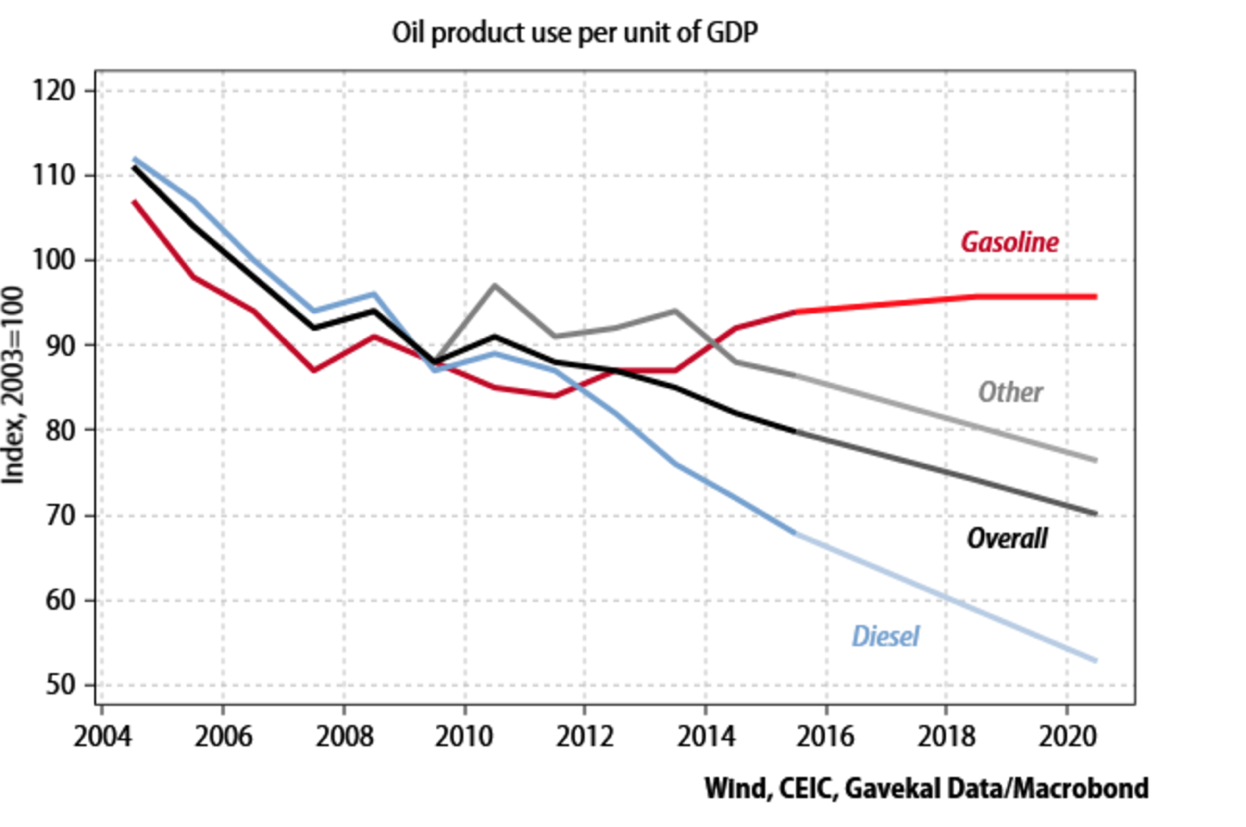The Wrong Peak, Part 3: Rebalancing Global Growth

by JACK HAYNIE, ’20
This article is part three of a four-part series. Read part two here.
While changes in the technology underlying oil’s role in the global economy have had and will have a profound impact on the future of petroleum demand, the changing pattern of growth in the global economy will have an equal, if not greater, impact. At present, a convergence of changing demographics and an economic transition are slowing the tremendous growth in global demand for commodities generally and oil specifically that the world had experienced for much of the past three decades. As developed nations age and developing nations transition away from energy-intensive industries towards the service sector, the near one-to-one ratio between growth and per capita energy consumption in low- and middle-income economies over the past thirty years has come undone.[1]
In many ways, the global delinking of economic growth from oil consumption should come as no surprise. The same transition has been occurring for years in many high-income economies, where the economic transition away from manufacturing, which heavily utilizes all carbon-based fuels (including oil), towards services has weakened the correlation between primary energy consumption and economic growth. As an example, the United States economy has grown by 12% since 2007; during that same period, carbon-based energy consumption per capita has fallen by 3.6%.[2] This inverse relationship between carbon emissions and GDP growth has already materialized in 35 different countries.[3]
These outcomes contradict decades of conventional wisdom that energy consumption would closely track economic growth. Instead, GDP has become less dependent on transportation infrastructure and the production of goods using carbon-based manufacturing, and more dependent on the individual productivity of service workers, who need a fraction of the petroleum products required by the heavily industrial economic processes that drive growth in many developing economies.[4]
While petroleum use has decoupled from growth in the increasingly service-dependent developed world, many developing economies have not picked up the slack created by a less oil-hungry west, either due to the developing world’s deliberate transition away from industrial growth or due to global economic woes. China, for example, has started deliberately moving its economy away from heavy industry in order to stimulate growth in the service sector,[5] a goal that is highlighted in the country’s most recent 5-year plan. The shutdown of almost 10% of the country’s oil refining capacity in summer 2017[6] illustrates the mismatch between current demand growth and the historical expectation of Chinese petroleum consumption. While some of this slowdown is attributable to the shutdown of out-of-date teapot refineries, refining was slowed at even the most modern facilities.
All told, even in a high-growth scenario, attempts by developing economies to shift to a service-based economic model along the lines of the West will cut the carbon intensity of global growth (the amount of energy consumed for each unit of GDP growth) by half.[7] China’s carbon intensity, especially qua diesel, has fallen drastically demonstrating the shift of the Chinese economy away from carbon-intensive manufacturing[8]. Should the status quo continue, it is likely that China will follow South Korea’s example, where for decades, GDP growth was almost directly tied to growth in fuel consumption, as economic activity was fueled mainly by heavy industry. The Korean economy has since shifted to more closely resemble Japan, the United States, and Europe, and GDP has continued to grow as energy consumption has leveled off.[9]
Even in developing economies without active policies of shifting growth away from the industrial sector, deindustrialization has occurred involuntarily from the cooling off of the massive emerging market boom of the past twenty-five years. In some regions, such as Africa, the carbon-based industrialization many development experts expected never materialized due to a lack of infrastructure and poor governance, leaving energy demand growth more anemic than countries with comparable economic growth rates.[10] Given the reliance of oil demand growth on these economies, any economic slowdown in developing states will have a disproportionate impact on oil consumption. As an example, a 25% reduction in new car sales in the developing world would reduce projected oil demand in the year 2050. Assuming that general growth trends from 2000 on continue to hold, this moderation of growth will drive a 40% decline in the carbon intensity of the global economy by 2030 and an attendant reduction in oil demand growth to 69% of contemporary levels.[11]
Compounding the effects of the shift away from traditionally petroleum-reliant sectors, the world’s aging population will present an increasing headwind for energy demand growth by lowering economic growth rates and exacerbating the decarbonization of the global economy.
Much like the global rebalancing towards the service sector, the aging of the global population is a departure from a previous trend. The global population saw the addition of an extra four billion people during the second half of the twentieth century,[12] which occurred simultaneously with the single greatest period of economic,[13] and subsequently energy demand growth, in human history.[14] This period of booming population growth fueled by industrialization is now over. Almost everywhere, particularly in the developed world, the global population is aging. According to United Nations projections, between 2015 and 2030, the global population over the age of 60 will increase from 12.3% of the population to 16.5% of the population, a 4% increase as compared to the 2.3% increase between 2000 and 2015 In the developed economies of the 2050s, a group which will include China, those over 60 will make up a quarter of the population. Even in Africa, the only region to exhibit significant population growth over this period, those over 60 will represent a drastically larger proportion of the population than they do today. This trend will only accelerate over time and by 2050, 44% of the global population will live in “relatively aged countries” where at least 20% of the population is over 60 and 25% will live in societies where that number exceeds 30%.[15]
This trend will have a definite impact on global petroleum demand. The elderly almost universally earn less, are less mobile, and consume less energy than their younger counterparts.[16] This is shown empirically by a study produced by the White House Council on Economic Advisors, which demonstrated a negative correlation between fuel usage and age in an analysis of consumer habits between 1990 and 2009.[17] As a result, global GDP growth rates, and subsequently global energy demand, will flatten substantially. One study concluded that GDP growth over the next 50 years will be 40% lower than GDP growth for the past 50 years.[18]
This will directly alter petroleum demand since, despite global GDP growth’s falling carbon intensity, growth remains correlated to oil demand expansion.[19] Additionally, aging itself will impact global energy usage since economies with an older population tend to be less carbon-intense. Research by the National Academy of Sciences has shown that slowing global population growth will directly lead to a 16-29% drop in the consumption of carbon-based energy compared to its baseline scenario over the next 35 years, a number which equates to 2.7 million barrels of oil a day in lost demand by the end of the scenario’s timeframe.[20][21][22] Most industry predictions of demand change fail to account for this global shift in consumption patterns. This general trend towards an aging global population, in combination with an economy increasingly geared toward services, will negatively affect oil demand.
Works Cited
[1] Helbing, Thomas, Joong Shik Kang, Michael Kumhof, Dirk Muir, Andrea Pescatori, and Shaun Roache. “Oil Scarcity, Growth, and Global Imbalances.” The IMF World Economic Outlook, April 2011, 89-124.
[2] “The Multiple Paths to Peak Oil Demand.” https://www.bcg.com. July 21, 2017. Accessed January 25, 2019. https://www.bcg.com/publications/2017/energy-environment-upstream-oil-gas-multiple-paths-peak-oil-demand.aspx.
[3] “The 35 Countries Cutting the Link between Economic Growth and Emissions.” Carbon Brief. April 05, 2016. Accessed January 25, 2019. https://www.carbonbrief.org/the-35-countries-cutting-the-link-between-economic-growth-and-emissions.
[4] Fankhauser, Sam. “Economic Growth and Development with Low-Carbon Energy.” Centre for Climate Change Economics and Policy Working Papers, no. 301 (March 2017).
[5] “Is Peak Oil Demand in Sight? | McKinsey.” Accessed January 25, 2019. https://www.mckinsey.com/industries/oil-and-gas/our-insights/is-peak-oil-demand-in-sight.
[6] “Looming Chinese Refinery Cuts to Hit Oil Demand | Reuters.” Accessed January 25, 2019. https://www.reuters.com/article/us-china-oil-demand-analysis-idUSKBN19C168.
[7] “Five Key Questions Clients Ask about Our Energy Demand Outlook to 2050 | McKinsey.” Accessed January 25, 2019. https://www.mckinsey.com/industries/oil-and-gas/our-insights/five-key-questions-clients-ask-about-our-energy-demand-outlook-to-2050.
[8] “The Future Of China’s Oil Demand (I) | Research.” Accessed January 25, 2019. http://research.gavekal.com/article/future-china%E2%80%99s-oil-demand-i.
[9] Kim, Cheol-hyeon. “Korea Energy Demand Outlook.” Korea Energy Demand Outlook 18, no. 1 (n.d.).
[10] Grabowski, Richard. “Deindustrialization in Africa.” International Journal of African Development 3, no. 3 (Fall 2015).
[11] Olsen, Yuliya. “Global Oil Supply & Demand Outlook to 2030.” Mckinsey Energy Insights, 2017.
[12] Bongaarts, John. “Human Population Growth and the Demographic Transition.” Philosophical Transactions of the Royal Society B: Biological Sciences 364, no. 1532 (October 27, 2009): 2985–90. https://doi.org/10.1098/rstb.2009.0137.
[13] Maddison, Angus. “The World Economy in the Second Half of the Twentieth Century,” The World Economy: A Millennial Perspective, Vol. 2, OECD Publishing.
[14] Helbing, Thomas, Joong Shik Kang, Michael Kumhof, Dirk Muir, Andrea Pescatori, and Shaun Roache. “Oil Scarcity, Growth, and Global Imbalances.” The IMF World Economic Outlook, April 2011, 89-124.
[15] United Nations, World Population Aging 2015. “World Population Ageing Report 2015.” The United Nations, 2015.
[16] O’Neill, Brian C., Michael Dalton, Regina Fuchs, Leiwen Jiang, Shonali Pachauri, and Katarina Zigova. “Global Demographic Trends and Future Carbon Emissions.” Proceedings of the National Academy of Sciences 107, no. 41 (October 12, 2010): 17521–26. https://doi.org/10.1073/pnas.1004581107.
[17] The Executive Office of the President. “EXPLAINING THE U.S. PETROLEUM CONSUMPTION SURPRISE.” The Executive Office of the President, June 2015.
[18] “Is Peak Oil Demand in Sight? | McKinsey.” Accessed January 25, 2019. https://www.mckinsey.com/industries/oil-and-gas/our-insights/is-peak-oil-demand-in-sight.
[19] Rabah Arzeki, Zoltan Jakab, Douglas Laxton, Akito Matsumoto, Armen Nurbekyan, Hou Wang, and Jiaxiong Yao. “Oil Prices and the Global Economy.” The International Monetary Fund, January 2017.
[20] US EPA, OAR. “Greenhouse Gases Equivalencies Calculator – Calculations and References.” Data and Tools. US EPA, August 10, 2015. https://www.epa.gov/energy/greenhouse-gases-equivalencies-calculator-calculations-and-references.
[21] O’Neill, Brian C., Michael Dalton, Regina Fuchs, Leiwen Jiang, Shonali Pachauri, and Katarina Zigova. “Global Demographic Trends and Future Carbon Emissions.” Proceedings of the National Academy of Sciences 107, no. 41 (October 12, 2010): 17521–26. https://doi.org/10.1073/pnas.1004581107.
[22] “Oil Sands up Close.” Center for Climate and Energy Solutions (blog), November 28, 2012. https://www.c2es.org/2012/11/oil-sands-up-close/.





